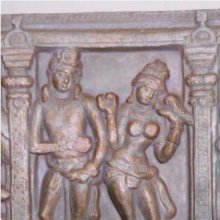Mithuna: 19 definitions
Introduction:
Mithuna means something in Buddhism, Pali, Hinduism, Sanskrit, Jainism, Prakrit, Marathi, Hindi. If you want to know the exact meaning, history, etymology or English translation of this term then check out the descriptions on this page. Add your comment or reference to a book if you want to contribute to this summary article.
Alternative spellings of this word include Mithun.
Images (photo gallery)
(+7 more images available)
In Hinduism
Vastushastra (architecture)
Source: Wisdom Library: Vāstu-śāstraMithuna (मिथुन) corresponds with the Gemini zodiac sign and refers to the third of twelve rāśi (zodiacal sign), according to the Mānasāra. Rāśi is one of the three alternative principles, besides the six āyādiṣaḍvarga, used to constitute the “horoscope” of an architectural or iconographic object. Their application is intended to “verify” the measurements of the architectural and iconographic object against the dictates of astrology that lay out the conditions of auspiciousness.
The particular rāśi (e.g., mithuna) of all architectural and iconographic objects (settlement, building, image) must be calculated and ascertained. This process is based on the principle of the remainder. An arithmetical formula to be used in each case is stipulated, which engages one of the basic dimensions of the object (breadth, length, or perimeter/circumference). All twelve rāśis, except the eighth (vṛścika) are auspicious.

Vastushastra (वास्तुशास्त्र, vāstuśāstra) refers to the ancient Indian science (shastra) of architecture (vastu), dealing with topics such architecture, sculpture, town-building, fort building and various other constructions. Vastu also deals with the philosophy of the architectural relation with the cosmic universe.
Vaishnavism (Vaishava dharma)
Source: Pure Bhakti: Arcana-dipika - 3rd EditionMithuna (मिथुन) corresponds to “gemini” (mid June to mid July) and refers to one of the zodiac signs (rāśī) in the Vedic calendar.—Rāśī refers to the different signs of the zodiac through which the sun travels. For precise dates, please refer to a Vedic calendar. In accordance with the zodiac sign the sun is situated in, one would utter [for example, mithuna-rāśī sthite bhāskare]

Vaishnava (वैष्णव, vaiṣṇava) or vaishnavism (vaiṣṇavism) represents a tradition of Hinduism worshipping Vishnu as the supreme Lord. Similar to the Shaktism and Shaivism traditions, Vaishnavism also developed as an individual movement, famous for its exposition of the dashavatara (‘ten avatars of Vishnu’).
Jyotisha (astronomy and astrology)
Source: Wisdom Library: Brihat Samhita by VarahamihiraMithuna (मिथुन) refers to the sign of Gemini, according to the Bṛhatsaṃhitā (chapter 5), an encyclopedic Sanskrit work written by Varāhamihira mainly focusing on the science of ancient Indian astronomy astronomy (Jyotiṣa).—Accordingly, “If the sun and moon should begin to be eclipsed when only half risen, deceitful men will suffer as well as sacrificial rites. [...] If they should be eclipsed when in the sign of Gemini (Mithuna), chaste women, princes, powerful petty chiefs, learned men, people living on the banks of the Yamunā and the rulers of Bahlikā and Matsya with their subjects will suffer miseries. If they should be eclipsed when in the sign of Cancer (Karka) the Ābhīras, the Śabaras, the Pallavas, the Mallas, the Matsyas, the Kurus, the Śakas, the Pāñcālas and the Vikalās will be afflicted with miseries and food grains will be destroyed”.

Jyotisha (ज्योतिष, jyotiṣa or jyotish) refers to ‘astronomy’ or “Vedic astrology” and represents the fifth of the six Vedangas (additional sciences to be studied along with the Vedas). Jyotisha concerns itself with the study and prediction of the movements of celestial bodies, in order to calculate the auspicious time for rituals and ceremonies.
In Buddhism
Tibetan Buddhism (Vajrayana or tantric Buddhism)
Source: Wisdom Library: Tibetan BuddhismMithuna (मिथुन) is the name of a Rāśi (zodiac sign) mentioned as attending the teachings in the 6th century Mañjuśrīmūlakalpa: one of the largest Kriyā Tantras devoted to Mañjuśrī (the Bodhisattva of wisdom) representing an encyclopedia of knowledge primarily concerned with ritualistic elements in Buddhism. The teachings in this text originate from Mañjuśrī and were taught to and by Buddha Śākyamuni in the presence of a large audience (including Mithuna).

Tibetan Buddhism includes schools such as Nyingma, Kadampa, Kagyu and Gelug. Their primary canon of literature is divided in two broad categories: The Kangyur, which consists of Buddha’s words, and the Tengyur, which includes commentaries from various sources. Esotericism and tantra techniques (vajrayāna) are collected indepently.
In Jainism
General definition (in Jainism)
Source: Encyclopedia of Jainism: Tattvartha Sutra 7: The Five VowsMithuna (मिथुन) according to the 2nd-century Tattvārthasūtra 7.15.—What is meant by mithuna? The union of male and female is called mithuna. What is meant by maithuna /copulation? The indulgence of man and woman in lustful activity owing to the rise of conducts deluding karmas.

Jainism is an Indian religion of Dharma whose doctrine revolves around harmlessness (ahimsa) towards every living being. The two major branches (Digambara and Svetambara) of Jainism stimulate self-control (or, shramana, ‘self-reliance’) and spiritual development through a path of peace for the soul to progess to the ultimate goal.
Languages of India and abroad
Pali-English dictionary
Source: BuddhaSasana: Concise Pali-English Dictionarymithuna : (nt.) a pair of a male and a female.

Pali is the language of the Tipiṭaka, which is the sacred canon of Theravāda Buddhism and contains much of the Buddha’s speech. Closeley related to Sanskrit, both languages are used interchangeably between religions.
Marathi-English dictionary
Source: DDSA: The Molesworth Marathi and English Dictionarymithuna (मिथुन).—n (S) Congress of the sexes. 2 m A sign of the Zodiac, Gemini. 3 n A couple or pair, a brace (male and female).
Source: DDSA: The Aryabhusan school dictionary, Marathi-Englishmithuna (मिथुन).—n A couple. m A sign of Gemini.
Marathi is an Indo-European language having over 70 million native speakers people in (predominantly) Maharashtra India. Marathi, like many other Indo-Aryan languages, evolved from early forms of Prakrit, which itself is a subset of Sanskrit, one of the most ancient languages of the world.
Sanskrit dictionary
Source: DDSA: The practical Sanskrit-English dictionaryMithuna (मिथुन).—a. [mith-unan kicca Uṇādi-sūtra 3.55] Paired, forming a pair, or couple.
-naḥ Ved. A pair, couple.
-nam 1 A pair, couple; मिथुनं परिकल्पितं त्वया सहकारः फलिनी च नन्विमौ (mithunaṃ parikalpitaṃ tvayā sahakāraḥ phalinī ca nanvimau) R.8.61; Meghadūta 18; Uttararāmacarita 2.5.
2) Twins.
3) Union, junction.
4) Sexual union, copulation, cohabitation
5) The third sign of the zodiac, Gemini.
6) (In gram.) A root compounded with a preposition.
Source: Cologne Digital Sanskrit Dictionaries: Shabda-Sagara Sanskrit-English DictionaryMithuna (मिथुन).—n.
(-naṃ) 1. A couple, a pair, a brace, male and female. 2. Copulation. 3. Union, junction. 4. Twins. 5. A root compounded with a preposition, (in gram.) m.
(-naḥ) The sign Gemini of the zodiac. E. mith to unite, unan Unadi aff.
Source: Cologne Digital Sanskrit Dictionaries: Benfey Sanskrit-English DictionaryMithuna (मिथुन).—[mith + una] (for + vana), I. n. 1. A couple, [Uttara Rāmacarita, 2. ed. Calc., 1862.] 36, 8. 2. Copulation. 3. Union. Ii. m. The sign of the zodiac, Gemini.
Source: Cologne Digital Sanskrit Dictionaries: Cappeller Sanskrit-English DictionaryMithuna (मिथुन).—[adjective] paired, forming a pair; [neuter] pair (male and female), twin couple, couple or pair i.[grammar] (in Veda mostly [masculine] [dual]); cohabitation, copulation, union, junction i.[grammar] Abstr. mithunatva [neuter], mithunabhāva [masculine]
Source: Cologne Digital Sanskrit Dictionaries: Monier-Williams Sanskrit-English Dictionary1) Mithuna (मिथुन):—[from mith] a mf(ā)n. paired, forming a pair
2) [v.s. ...] m. a pair (male and female; but also ‘any couple or pair’ [Ṛg-veda] etc. etc., usually [dual number], in later language mostly n.; ifc. f(ā). )
3) [v.s. ...] n. pairing, copulation, [Taittirīya-saṃhitā] etc. etc.
4) [v.s. ...] a pair or couple (= m.; but also ‘twins’), [Mahābhārata]
5) [v.s. ...] (also m.) the sign of the zodiac Gemini or the third arc of 30 degrees in a circle, [Sūryasiddhānta; Varāha-mihira; Purāṇa]
6) [v.s. ...] the other part, complement or companion of anything, [Mahābhārata] (also applied to a kind of small statue at the entrance of a temple, [Varāha-mihira’s Bṛhat-saṃhitā])
7) [v.s. ...] honey and ghee, [cf. Lexicographers, esp. such as amarasiṃha, halāyudha, hemacandra, etc.]
8) [v.s. ...] (in gram.) root compounded with a Preposition, [Siddhānta-kaumudī]
9) b etc. See p. 816, col. 3.
Source: Cologne Digital Sanskrit Dictionaries: Yates Sanskrit-English DictionaryMithuna (मिथुन):—(naṃ) 1. n. A couple; copulation; union. m. Gemini.
Source: DDSA: Paia-sadda-mahannavo; a comprehensive Prakrit Hindi dictionary (S)Mithuna (मिथुन) in the Sanskrit language is related to the Prakrit word: Mihuṇa.
[Sanskrit to German]
Sanskrit, also spelled संस्कृतम् (saṃskṛtam), is an ancient language of India commonly seen as the grandmother of the Indo-European language family (even English!). Closely allied with Prakrit and Pali, Sanskrit is more exhaustive in both grammar and terms and has the most extensive collection of literature in the world, greatly surpassing its sister-languages Greek and Latin.
Hindi dictionary
Source: DDSA: A practical Hindi-English dictionaryMithuna (मिथुन) [Also spelled mithun]:—(nm) a couple, pair; mating, (sexual) union; the third sign of the zodiac-Gemini; ~[nīkarana] mating.
...
Kannada-English dictionary
Source: Alar: Kannada-English corpusMithuna (ಮಿಥುನ):—
1) [noun] two similar or corresponding things joined, associated or used together; a pair.
2) [noun] a pair of a male and a female.
3) [noun] two persons or animals born at the same birth; twins.
4) [noun] the act or an instance of sexual intercourse; coition.
5) [noun] (astron.) a northern constellation between Cancer and Taurus, containing the bright stars Castor and Pollux; Gemini.
6) [noun] (astrol.) the third sign of the zodiac; Gemini.
Kannada is a Dravidian language (as opposed to the Indo-European language family) mainly spoken in the southwestern region of India.
See also (Relevant definitions)
Starts with: Mithuna-gai, Mithunabhava, Mithunakrsha, Mithunatva, Mithunavratin, Mithunay, Mithunaya, Mithunayamaka, Mithunayate, Mithunayoni, Mitunam, Mitunaviti.
Ends with: Amithuna, Amtarmithuna, Anyonyamithuna, Atmamithuna, Cakramithuna, Dasamithuna, Devamithuna, Devatamithuna, Gomithuna, Namithuna, Nrimithuna, Samithuna, Vimithuna.
Full-text (+58): Gomithuna, Anyonyamithuna, Mithunavratin, Mithunabhava, Mithunayamaka, Nrimithuna, Maithuna, Mithunayoni, Mithunatva, Mithuni, Mithunakrsha, Gramyarashi, Mithunibhava, Mihuna, Devamithuna, Maiyuna, Phalini, Amithuna, Vimithuna, Dasamithuna.
Relevant text
Search found 37 books and stories containing Mithuna, Mithuṇa; (plurals include: Mithunas, Mithuṇas). You can also click to the full overview containing English textual excerpts. Below are direct links for the most relevant articles:
Amaravati Art in the Context of Andhra Archaeology (by Sreyashi Ray chowdhuri)
The mithuna couple < [Chapter 5 - Impact of Amarāvatī Art]
Resemblance to Deccan art < [Chapter 5 - Impact of Amarāvatī Art]
Lower Kṛṣṇā Valley (6): Goli < [Chapter 2 - Amarāvatī and other Archaeological Sites of Ancient Andhra Pradesh]
Sripura (Archaeological Survey) (by Bikash Chandra Pradhan)
Secular Stone Sculptures < [Chapter 3 - Sculptural Programme]
Tivaradeva Vihara (SRP-5) < [Chapter 2 - The Architectural Panorama]
Sasai Maha Vihar (SRP-I) < [Chapter 2 - The Architectural Panorama]
Cidgaganacandrika (study) (by S. Mahalakshmi)
Verse 8 [The true nature of the dual-deity the Kāla-Kāli] < [Chapter 1 - First Vimarśa]
Part 1c - Tantric character of Krama < [Krama system and Trika school]
Verse 37 [Bindu and Visarga] < [Chapter 2 - Second Vimarśa]
Chandogya Upanishad (Madhva commentary) (by Srisa Chandra Vasu)
Second Adhyaya, Thirteenth Khanda (1 mantra)
Seventh Adhyaya, Fifteenth through Twenty-sixth Khandas (18 mantras)
Puranic encyclopaedia (by Vettam Mani)
Sahitya-kaumudi by Baladeva Vidyabhushana (by Gaurapada Dāsa)
Text 10.251 < [Chapter 10 - Ornaments of Meaning]
Related products






